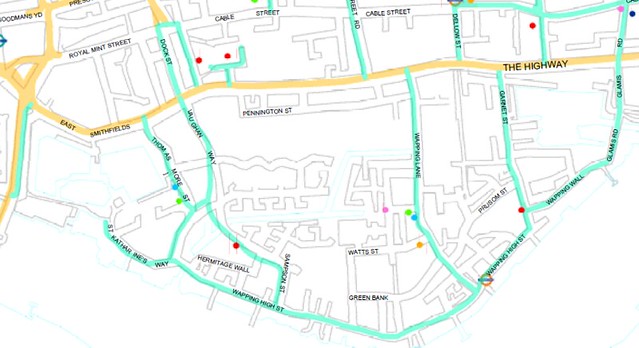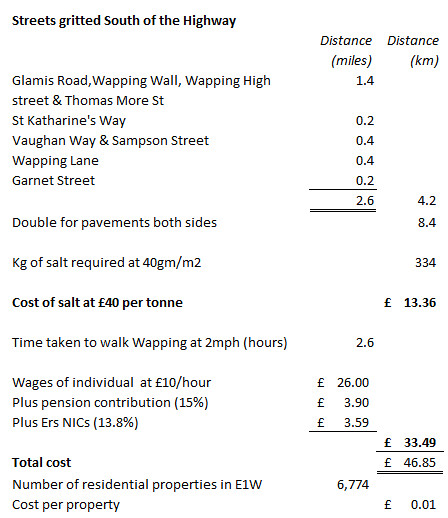Gritting Stuff
Modelling the weather is tricky, modelling cost less so
Given the uneven gritting that I observed over the weekend, I started to wonder:
Given the uneven gritting that I observed over the weekend, I started to wonder:
a) Which pavements do LBTH grit; and
b) How much does it cost to grit a pavement?
The answer to a) I discovered whilst researching b), which was handy.
In Wapping, the pavements gritted by LBTH are Glamis Road, Wapping Wall, Garnet St, Wapping High St, Wapping Lane, Sampson Street, Vaughan Way, Stockholm Way, Thomas More St and St Katharine’s Way. The Highway is the responsibility of TfL. The borough map can be found here and for convenience Wapping is shown below (for info the roads gritted are shown here. Coloured dots represent priority areas. Using google maps, I estimate the distance to be 2.6 miles.
In Wapping, the pavements gritted by LBTH are Glamis Road, Wapping Wall, Garnet St, Wapping High St, Wapping Lane, Sampson Street, Vaughan Way, Stockholm Way, Thomas More St and St Katharine’s Way. The Highway is the responsibility of TfL. The borough map can be found here and for convenience Wapping is shown below (for info the roads gritted are shown here. Coloured dots represent priority areas. Using google maps, I estimate the distance to be 2.6 miles.

My observation from walking the mean streets of Wapping is that whilst the pavements highlighted were gritted on Friday night/Saturday morning, it appeared to me that at 11am(ish) when I bumped into WiW and LoveWapping, that in large areas it was only one side of the roads and that if cars were parked on the road the grit spreader couldn’t grit the pavement, so large patches of pavement were left ungritted. Even on Monday evening and Tuesday morning there were parts of Vaughan Way, Sampson Street, Thomas More and Wapping High St which had not be gritted.
So, moving onto b) how much does it cost? The details of the calculation I performed are below if you're that way inclined. If LBTH gritted the pavements they were meant to, using only manual labour and no gritting truck, the cost would be a measly £47, or one pence per property. I then wondered what the cost might be for LBTH to grit every single pavement in the borough, and came up with £3,910, which is equivalent to £0.03 per property.
I can't really contextualise this using the usual metrics of football pitches, double decker buses, Nelson's Column etc, but what I can say is that you use the increase in the Mayor's Office's budget to grit roads, you could grit every pavement 71 times.
I'm not making a party political point, but I find it mildly annoying that I went out and spent about 4 hours of my weekend salting a few hundred metres of pavements and clearing them of snow (as they hadn't been salted). Bizarrely I read the weather forecast and bought salt and a shovel and was prepared. What I would prefer the council to do is speak to the community and ask volunteers to assist with such work. I would happily spend several hours pushing a grit spreader round the pavements knowing that doing so would stop vulnerable people being left house bound.
Workings
Cost of salt
I started by establishing what the going rate for grit is. Various websites will sell you a tonne for £190-240 (see here and here), though I haven't tried shopping round. However, a BBC story from 2009 based on FOI requests found most councils paid around £20-25 a tonne. I will use this as the base for my calculation, but will uplift to £40 for inflation and not being too unrealistic in my expectations.
How much salt is needed
This website on highway maintenance suggests you need 20-40g of salt per square metre for snow, so I'll go with 40 and be generous (this is supported by this Peterborough Council web page).
Assumptions
I'll assume that we want to clear a path 1 metre wide (which is wider that some of the footpaths in question) on both sides of the road (a luxury I know). The London living wage is £8.30, which I round to £10 to factor in for any specialist skills needed. I'm also assuming the use of a manual grit spreader as I can't find an 'on the road' price for gritters and assume the person spreading salt walks at a cautious 2mph. I think that in reality they would walk faster, but this builds in some tolerance for topping up salt.
I assume that gritting may be done at unsociable hours, but I think this is mainly the case for when a vehicle is used, so it doesn't fire grit at passers by, so haven't factored in double time etc. You can get spreaders that attach to pickup trucks for less than £1k, so using existing park service vehicles, you could speed up the process (which is where most of the cost comes in), with supplementary manual gritting, but I don't model this.
I also haven't modelled the time to get to the bit of St Katharine's way by Tower Bridge, this might be more sensibly done by whoever did Trinity Square, but I have included the time to grit, to reflect a truish cost of gritting the area.
I have worked out that you can walk all of the footpaths that are salted in Wapping in a long loop by doubling back only once, at a distance of 100m or so, so the need to replenish wouldn't require too much time if you planned where to drop a stockpile.

Working through my steps, you can see that 2.6 miles is 4.2 km, which we double to 8.4 km, and at 1 metre wide, this is 8,400 square metres, each of which need 40g of salt, which is 334 kg of salt. At £40 a tonne, this is £13 of salt.
We then work out the cost of paying someone to do this - 2.6 hours, at £10 an hour with a 15% pension contribution and employers NICs at 13.8%, comes out at £33 quid, giving a total of £46.85.
From one of my FOI requests I know there are 6,774 residential properties in E1W, which broadly corresponds to South of the Highway and in turn means, it costs each property one pence to grit all of Wapping.
LBTH says it is responsible for the maintenance of 217 miles of roads, if you plug this in to my calculation, it comes out at £4k, which when shared over 112,000 properties is £0.03 each.


Comments
Post a Comment
Please leave a comment to let me know if you think I've got it totally or partially wrong!